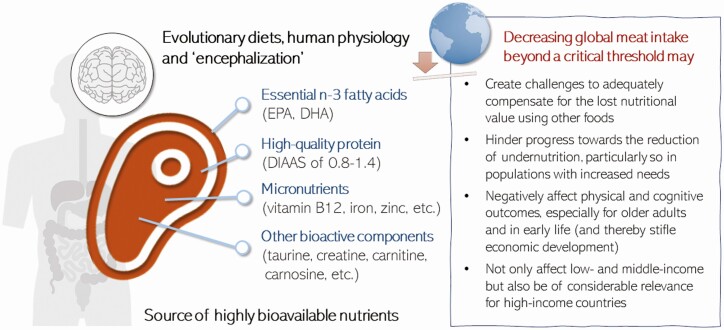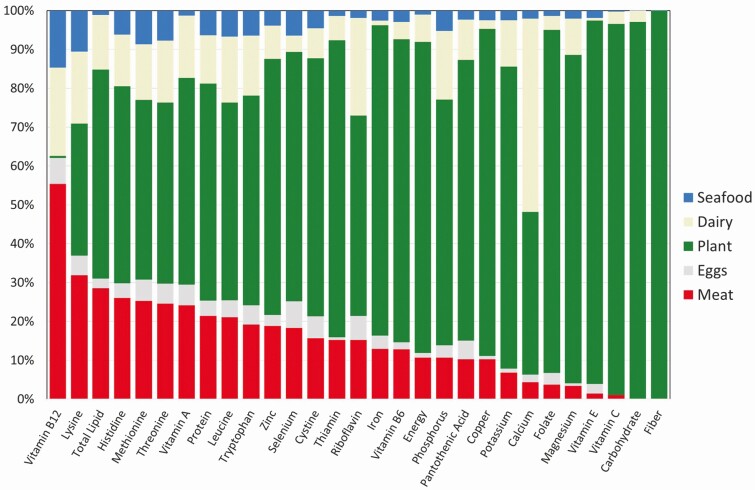Implications.
Aspects of human anatomy, digestion, and metabolism diverged from other primates, indicating evolutionary reliance on, and compatibility with, substantial meat intake. Implications of a disconnect from evolutionary dietary patterns may contribute to today’s burden of disease, increasing the risk for both nutrient deficiencies and chronic diseases.
Meat supplies high-quality protein and various nutrients, some of which are not always easily obtained with meat-free diets and are often already suboptimal or deficient in global populations. Removal of meat comes with implications for a broad spectrum of nutrients that need to be accounted for, whereas compensatory dietary strategies must factor in physiological and practical constraints.
Although meat makes up a small part (<10%) of global food mass and energy, it delivers most of the global vitamin B12 intake and plays a substantial role in the supply of other B vitamins, retinol, long-chain omega-3 fatty acids, several minerals in bioavailable forms (e.g., iron and zinc), and a variety of bioactive compounds with health-improving potential (e.g., taurine, creatine, and carnosine).
As a food matrix, meat is more than the sum of its individual nutrients. Moreover, within the diet matrix, it can serve as a keystone food in food-based dietary interventions to improve nutritional status, especially in regions that rely heavily on cereal staples.
Efforts to lower global meat intake for environmental or other reasons beyond a critical threshold may hinder progress towards reducing undernutrition and the effects this has on both physical and cognitive outcomes, and thereby stifle economic development. This is particularly a concern for populations with increased needs and in regions where current meat intake levels are low, which is not only pertinent for the Global South but also of relevance in high-income countries.
Introduction
Historically and from an evolutionary perspective, meat has been cherished by human communities as a nutritious and highly symbolic food, against a 3-million-year background of biosocial needs. Whenever intake was low, this was mostly due to limited access and availability or because of ideological and religious reasons. Today, however, arguments for a widespread reduction of meat consumption have emerged from various actors, mostly in high-income countries. Leaving aside the degree of negative impact that meat may have on a variety of factors that relate to human and planetary health (addressed elsewhere in this Issue; Johnston et al., 2023; Thompson et al., 2023), the purpose of the present article is to summarize the positive nutritional aspects of meat consumption. The outlining, understanding, and weighing of such parameters will be required to enable a proper cost-benefit analysis of any food system transformation, and particularly those that wish to strongly reduce or even eliminate meat intake.
Four key questions were identified by the authors of this article as paramount for this discussion and will be addressed below. First, to what degree can meat be considered as a part of the species-adapted diet of humans, and therefore as an appropriate food from a physiological and nutritional perspective? Second, what are the key nutrients that meat provides and could potentially become challenging to obtain from other sources in meat-free diets? Third, what is the current contribution of meat to the global supply of such nutrients and how does that differ regionally? Finally, what would be the implications of a substantial reduction in meat consumption on human nutrition and well-being at large, especially for populations with increased needs and in regions where intake is already worryingly low?
Meat and its Role in Evolutionary Diets
Humans and their hominin ancestors have been consuming meat for >3 million years (Mann, 2010, 2018). Dietary divergence of the hominin line from other apes on the African continent was induced by gradual climate change, which resulted in the expansion of drier grasslands and semi-forested regions. Digestible plant foods became less readily available than in wetland forests, but grazing animals were abundant. This led to a dietary shift towards fat and protein, accompanied by the physiological and metabolic adaptations that culminated in modern humans (Figure 1).
Figure 1.
Overview of the role of meat in human nutrition and of the potential complications if global meat consumption was to be restricted beyond a critical threshold.
Ancestral food intake habits have been determined based on a variety of methods, including anthropometry (e.g., cranio-dental changes, suggesting less emphasis on grinding and more on biting and tearing of flesh) and the analysis of the fossil record through a combination of scanning electron microscopy of teeth to reveal microwear patterns, stable isotope analysis in bone and teeth enamel to unravel the trophic level, and exploration of butchery practices, suggesting consumption of ungulate animals. Additional information was obtained using mathematical modeling (e.g., optimal foraging theory), and the study of modern hunter-gatherers as surrogate models of ancestral dietary practices.
Due to a process of ‘encephalization’, humans have a larger brain size than would be expected for their body size. To sustain an expansively large brain, energetic compensation was required during hominin evolution. When examining individual organs, the brain mass surplus (and its energy requirement), is closely balanced by the reduction in size (and energy requirement) of the gastrointestinal tract. This is not surprising, considering the gut is the only organ that can sufficiently vary in size to offset the metabolic cost of a larger brain (Aiello and Wheeler, 1995). This process required a shift from a diet high in bulky plants of low digestibility (requiring voluminous fermentation chambers such as a rumen or cecum, or an extensive colon), to a higher-quality diet where foods are more energy dense and require less digestive processing. In temperate grass and woodland environments, this equates to an animal-derived protein-rich and fat-rich diet (Speth, 1989). Based on their digestive system, humans are classified as omnivores, falling between their frugivorous anthropoid relatives (e.g., chimpanzees) and true carnivores. With a simple stomach, relatively elongated small intestine, and reduced cecum and colon, the human gut is suggestive of reliance on a high-quality diet in which meat was predominant. The intestinal length to body length ratio of humans (5:1) is like dogs (6:1) and markedly different to grazing mammals (cattle, 12:1). Another measure of digestive system structure is the gastrointestinal surface area to body surface area ratio, with humans (0.8:1) once again being more similar to carnivores (dogs, 0.6:1) than grazing mammals (cattle, 3:1) (Henneberg et al., 1998). Even compared with their closest evolutionary relatives, the chimpanzees and gorillas, humans have a distinct digestive tract that shows differences favoring reliance on higher-quality foods. The great apes, for instance, have the greatest volume of gastrointestinal tract devoted to the colon (>50%) for the fermentation of low-grade plant materials, compared with humans at <20%. Humans, on the other hand, have a relatively large small intestine similar to carnivores (~70%), compared with the great apes at 15–25% (Milton, 1986).
Adding to the above-mentioned anatomical and physiological observations, optimal foraging theory further explains the primordial role of meat in evolutionary diets. Survival depended on adequate daily energy balance, which is a function of the energy content of foods consumed minus the energy spent in obtaining those foods. Despite an abundance of edible (micronutrient-rich) plants in most geographic locations, the energy content of foods available was heavily weighted towards animal foods rich in protein and fat. Examining the dietary patterns of recent hunter-gatherers in terms of energy procurement gives an understanding of dietary practices of our evolving hominin and early human ancestors. In various hunter-gatherer societies, the principal foods providing the bulk of energy were found to be of animal origin. Using 20th-century data from South American hunter-gatherers, the energy return rates from peccary (65,000 kcal/h) and antelope (16,000–32,000 kcal/h) were high, whereas small animals such as squirrels, snakes, and birds still brought in around 5,000 kcal/h. The return rates from roots, fruits, and seeds, however, had a lower range of 500–6,000 kcal/h (Cordain et al., 2002). Even in societies that ranged over plains and jungle environments—having greater access to edible wetland plants compared to open rangelands—heavy reliance on animal foods was common. Analysis of the energy procurement of >200 geographically diverse hunter-gatherer societies show a median energy reliance on animal-sourced foods of around 60% (Cordain et al., 2000).
A disconnect from evolutionary dietary patterns may contribute to today’s burden of disease, at least in some age groups (Mann, 2010). This argument is likely to be more consequential during childhood, based on the intensified nutrient requirements for growth and brain development in the early phase of life. Animal-sourced foods, such as meat, are the best source of nutrient-rich foods for children aged 6–23 months (a finding supported by the World Health Organization), leading to compelling benefits on cognitive functions (Balehegn et al., 2019). Drawing on studies from 95 cultural groups, animal-sourced foods—and meat from ungulates particularly—were the most frequently mentioned food groups in child dietary patterns from an evolutionary perspective (Iannotti et al., 2022). Studies examining the health implications for children and youth in the transition from gatherer-hunter-fisher diets to agriculture subsistence reveal nutritional deficiencies, infection, and metabolic perturbations associated with reduced meat consumption and dietary diversity (e.g., Chinique de Armas and Pestle, 2018).
Essential Nutrients in Meat
It has been argued that public health policies need to assess the above-mentioned evolutionary knowledge when developing food-based dietary guidelines, especially for children (Iannotti et al., 2022). Today, meat has a key dietary role to play based on the density and bioavailability of its nutrients. Restricting its intake would imply that these nutrients will need to be supplied by other foods, or by fortification or supplementation. While this is theoretically possible, it may not be straightforward in practice, due to limitations at the level of resources, culinary skills, dietary culture and habits, or nutritional awareness and knowledge. Food intolerances and allergies (e.g., gluten, soy, or pea protein) further complicate the suitability of meat-free diets. As for all restrictive diets that exclude nutrient-rich food groups, whether by choice or necessity, the impact is particularly relevant for populations with elevated needs, such as children, women of reproductive age, older adults, and individuals in low- and middle-income countries. Below we list the key points of attention that individuals on meat-free diets need to consider.
Protein quality
Not all proteins are of equal nutritional value. It is essential to consider the content and digestibility of the indispensable amino acids (IAA) in a food, as these are the nutrients needed to synthesize bodily proteins. By acknowledging these aspects, encapsulated in the term ‘protein quality’, the efficacy of a food as a protein source can be better understood. In practice, protein quality is arguably best described using the Digestible Indispensable Amino Acid Score (DIAAS; Moughan, 2021). Its calculation requires information on the IAA contents of a food and provides estimates of their true ileal digestibility. A food is given a score of 1 or higher if the absorbed IAA are all utilizable, whereas a lower score indicates that only a portion of the absorbed IAA are available for utilization. For meat, DIAAS values fall in the range of 0.8–1.4, whereas values for most traditional plant proteins are markedly lower (Marinangeli and House, 2017). In general, values for legumes range between 0.4 and 1.1, which are like nuts (0.4–0.9) but generally higher than cereal foods (0.1–0.8). In plants, some IAAs are limiting, and digestibility is reduced due to complex plant cell structures and the presence of fiber and anti-nutritional factors (the effects of which can be partially attenuated through processing). Consequently, with some exceptions (e.g., certain soy-based foods), many protein-rich plant foods fail to reach the ‘good source of protein’ criterion (Marinangeli and House, 2017). When considering the nutritional value of protein sources, it is thus not sufficient to simply consider protein content. Low-quality protein sources are not fully utilizable unless combined with complementary protein sources, meaning that even an individual achieving the recommended gross protein intake may be deficient in IAA if the DIAAS score of their diet is <1. Because of its high DIAAS value, meat is an excellent complement to plant-sourced proteins.
Global analyses demonstrate a protein surplus in almost all countries, when benchmarked against RDA values. The latter, however, may be below optimal intake levels for large parts of the population (see below). Moreover, these approaches rarely consider protein quality. When adjusting for bioavailability, or when considering the bioavailable IAA supply, conclusions change. Moughan (2021) showed that >100 countries faced inadequate protein supply for their populations after consideration of bioavailability. These were predominantly lower-income countries, and the poorer bioavailability was attributed to low dietary diversity, including minimal access to animal-sourced foods.
Although it is often stated that individuals in high-income countries overconsume protein, that is, above the recommended daily allowance (RDA) of 0.83 g per kg bodyweight, this assertion ignores the effect of protein quality and is based on the minimum need to avoid loss of lean muscle mass in healthy populations. This is, however, not necessarily an optimal amount, as many populations may benefit from higher intake levels (e.g., twice the stated recommendation), especially in view of muscle building, pregnancy, lactation, healthy aging, and in the case of acute or chronic disease (Leroy et al., 2022). Meeting the same protein target with plant options, having typically lower DIAAS values, is feasible but requires specific dietary strategies. Besides for those deficient in protein, the effects of dietary protein quality are particularly important for people with relatively low energy intakes and targets for daily protein higher than the RDA.
Micronutrients
The current understanding of the bioavailability of nutrients in meat is most advanced for protein and amino acids, with varied understanding for other essential nutrients. Several of these nutrients are of key importance for global health, not least because they are to be considered crucial for the human brain: iron, zinc, and vitamin B12 (in addition to long-chain omega-3 fatty acids, see below). If not supplemented, these nutrients are either obtained exclusively from animal-sourced foods or are more bioavailable in those foods. In addition, meat contains a range of other B vitamins that can be limited in micronutrient-poor diets based on non-fortified cereal staples, including thiamine and niacin. However, nutrient levels vary considerably between categories of meat (e.g., ruminant meat, pork, poultry, and processed meats), as well as carcass cuts and fattiness. These differences can be further modulated by animal genetics, activity level, sex, and feed (e.g., at the level of essential fatty acid content). Organ meats are particularly reliable sources of vitamins A and D, iron, zinc, folate, selenium, and choline, of which the supply is often limiting at the global level, even in high-income countries (Stevens et al., 2022).
Most attention has been given to iron and zinc as essential micronutrients with acute and chronic health outcomes for deficiency, related to physical and cognitive development, physiological functioning, blood health, and immunity (Beal and Ortenzi, 2022). These minerals are contained in a wide range of foods of both animal and plant origin. However, plant foods often contain compounds that bind to these minerals and reduce their absorption (e.g., fiber, phytate, and phenolic compounds). Also, zinc is better absorbed from animal-sourced foods where it is in a protein-bound form, similar to the heme iron from animals which is more readily bioavailable than the non-heme iron found in plants. It has been estimated that the average bioavailability of iron and zinc in ruminant meat is 2 and 1.7 times as high, respectively, as that of pulses, like beans, lentils, and peas (Beal and Ortenzi, 2022). As a further complication, iron intake alone may be insufficient to treat anemia because other micronutrients, including vitamin A and B vitamins, are needed for iron mobilization and hemoglobin synthesis. Even if vegetarians have iron intakes above the recommended levels, and often even higher than those of omnivores, this usually still results in lower iron status. Similarly, meeting the recommended dietary intake is no guarantee for adequate zinc status. To account for the above-mentioned differences in bioavailability and to avoid deficiencies, higher recommended intakes are specified for individuals consuming diets with higher plant-sourced and lower animal-sourced food content (FAO/WHO, 2004).
Adequate intake of vitamin B12 is essential for normal blood function and neurological function. The vitamin is critical for nerve cell myelin synthesis and, with folate, for DNA synthesis. It is converted into a range of coenzyme forms in the human body, which play essential roles in numerous critical metabolic pathways. A range of neural and mental health related issues have been linked to vitamin B12 deficiency (e.g., fatigue, depression, poor memory, and mania) potentially leading to permanent damage in infants and toddlers. Almost all dietary intake of vitamin B12 is in the form of animal-sourced foods, meat being the most important source.
Long-chain omega-3 fatty acids
Omega-3 fatty acids are a family of polyunsaturated fatty acids of varying chain length and functionality in the human body. They are found in plants (α-linolenic acid in particular), but the longer chain forms, eicosapentaenoic acid (EPA) and docosahexaenoic acid (DHA), are only found in marine organisms and land herbivores. They are both critical agents in terms of cell membrane structure and tissue health (especially for the brain, heart, and retina), while also acting as precursors for a range of eicosanoids that affect the cardiovascular system and mitigate chronic inflammation. Human studies show numerous associations of DHA status, in particular with cognitive function, visual acuity, and brain development in children. The chain elongation and desaturation pathway common in most animals should theoretically allow the conversion of the shorter plant omega-3 fatty acids to EPA and DHA. However, in humans this pathway is inefficient, requiring humans to consume EPA and DHA preformed from animal tissue (Baker et al., 2016). Vegetarians and vegans tend to have lower levels of EPA and DHA in their plasma and erythrocytes, despite a higher status of α-linolenic acid (Rossell et al., 2005; Chamorro et al., 2020).
Other bioactive molecules and the role of the food and diet matrix
Besides containing a wide spectrum of essential nutrients, meat is a unique source of various non-essential yet biologically active molecules, such as taurine, creatine, anserine, carnosine, and 4-hydroxyproline (Wu, 2020). Their potential health advantages relate to healthy aging, skin and bone health, immunity, and the prevention of obesity and cardiovascular pathologies. These molecules are often overlooked in nutritional assessments and still represent only a fraction of the much broader and variable range of biochemical compounds that can be present in meat, modulated among other factors by the type of animal feed, and the diet at large (Barabási et al., 2020). Their impact on health is uncertain but hints to the importance of the entire food matrix, while cautioning against nutritional reductionism (Leroy et al., 2022). Meat is more than the sum of its individual nutrients (Klurfeld, 2023), for example, by regulating the absorption and metabolism of other nutrients.
A growing body of evidence supports the inclusion of animal-sourced foods in food-based dietary interventions for improving the nutritional status of populations, as compared to nutrient supplementation or fortified product programming (Bhutta et al., 2013). This may be partially explained by the potential health effects of many uncharacterized (or even unknown) compounds that are present in meat, but the complexity likely goes further. The bioavailability of nutritional compounds ultimately depends on the food and diet matrix. In recent years, food-based dietary guidelines have shifted towards recommending dietary patterns rather than prescriptive nutrient or food quantities (Herforth et al., 2019). This trend acknowledges cultural differences within and across countries, but also the public health importance of consuming patterns of food groups within a wholesome diet matrix. Meat consumed in appropriate levels serves as a keystone food in this system. For instance, resource-poor countries suffer from highly prevalent stunting and other forms of malnutrition, in part due to inadequate dietary diversity (including low intake of animal-sourced foods) and a heavy reliance on a single staple (typically cereal) for daily energy needs (Ranum et al., 2014). Meat can help improve mineral bioavailability particularly in the context of plant-centered diets that are high in phytates (e.g., from maize).
Contribution of Meat to Global Nutrient Supply
Using global food production, loss, and use data, it has been possible to understand how global nutrient supplies from food matches up to global population requirements. The DELTA Model® has shown that meat contributed the majority of the global vitamin B12 supply, as well as a quarter of vitamin A (in retinol equivalents; mostly from organ meats and poultry), and high proportions of other B vitamins and several minerals (Figure 2; Smith et al., 2022). This data should be seen in combination with the sufficiency of global supply: the model has estimated that the supply of iron, zinc, vitamin A, and vitamin B12 exceeds global requirements by <10%, uncorrected for bioavailability, making meat’s contribution all the more critical. This contribution should be weighed against the fact that meat makes up a small part (<10%) of both global food mass and energy, providing further evidence for its nutrient density.
Figure 2.
The contribution of food groups to the global supply of nutrients and dietary fiber from food, with all forms of meat for human consumption (including organ meat and processed meats) highlighted. The values for protein and the indispensable amino acids have been corrected for bioavailability from the contributing food items, but not for minerals and vitamins (note that, for instance, the average bioavailability of iron and zinc in ruminant meat is 2 and 1.7 times as high, respectively, as that of pulses; Beal and Ortenzi, 2022). Adapted from Smith et al. (2022).
This global picture does not capture regional variation. In the case of unprocessed red meat, the average per capita daily consumption is estimated at just 7 g in South Asia, 24 g in Sub-Saharan Africa, 36 g in the Middle East and North Africa, 45 g in high-income countries, 51 g globally, 68 g in Latin America and Caribbean, 87 g in Southeast and East Asia, and a sizable 114 g in Central or Eastern Europe and Central Asia (Miller et al., 2022). Regions with the lowest intake also show the highest prevalence of undernutrition (Adesogan et al., 2020; Stevens et al., 2022).
Potential Global Implications of Meat Restriction
There are potential nutritional benefits and risks associated with restricting meat, which vary by context, population, life course phase, and replacement food. In many low- and middle-income countries, particularly in Sub-Saharan Africa and South Asia, meat intake is very low, and undernutrition is high (Miller et al., 2022). These populations could benefit from an increased rather than reduced meat intake (Adesogan et al., 2020). Thus, global efforts to moderate meat intake for environmental or other reasons should be careful not to restrict its growth in populations where consumption is already low, as this could hinder progress towards reducing undernutrition and thereby not address human suffering and the stifling of economic development (Balehegn et al., 2019).
Even in high-income countries, a reduction in meat from current intake levels (e.g., in view of non-communicable risk reduction; see elsewhere in this Issue, Johnston et al., 2023), needs to be considered in conjunction with its impact on nutrient status (Beal and Ortenzi, 2022; Stevens et al., 2022). Particular phases of the life course necessitate nutrient-dense, bioavailable foods to fulfill requirements: women of reproductive age, pregnant and lactating women, infants and young children, and older adults. Changing diets in high-income countries, which tend to be associated with decreasing red meat intake, parallel rising iron deficiency (for the USA, Sun and Weaver, 2021). For women of reproductive age, iron requirements can be challenging to meet on any diet but restricting ruminant meat—among the densest sources of bioavailable iron—complicates the problem in the absence of careful efforts to consume iron-fortified foods or supplements. Over 20% of these women in the United States and United Kingdom are deficient in iron alone, while one-third of these women in the United States and one-half in the United Kingdom are deficient in one or more micronutrients (Stevens et al., 2022).
Besides leading to anemia, iron deficiency may also lower cognitive performance in women (Murray-Kolb and Beard, 2007), potentially affecting the healthy development of their offspring. Correlational studies show an association between iron deficiency anemia and poor cognitive and motor development, along with behavioral problems and learning difficulties which continue into middle childhood. Furthermore, low maternal zinc intake during pregnancy and lactation is associated with less focused attention and decreased motor function in neonates, while zinc supplementation in infants can lead to increased activity and functionality (Bhatnagar and Taneja, 2001). Similar arguments can be made for EPA/DHA and vitamin B12, given their key role in neural and brain health (Baker et al., 2016; Balehegn et al., 2019). When strict vegetarian upbringing results in deficiencies of these nutrients, physical and cognitive development will be compromised (Leroy and Barnard, 2020). As argued above with respect to the evolutionary implications of a dietary disconnect, young children (6–23 m) have high iron and other nutrient requirements and their development may be impacted with reduced meat intake. Although this would have to be further confirmed by a comprehensive risk assessment, several pediatric associations have already expressed their concern when it comes to vegan and, to a lesser degree, vegetarian upbringing (e.g., the German Society for Pediatrics and Nutrition Science, Swiss Federal Commission for Nutrition, and Belgian Royal Academy of Medicine).
In low- and middle-income countries, numerous studies show that the consumption level of animal-sourced foods in general is positively associated with cognitive development, verbal ability, activity level, and behavior in children (Adesogan et al., 2020). Beyond these potentially confounded associations, the administration of meat in intervention studies is also known to improve the zinc and iron status of infants (Obbagy et al., 2019), as well as the behavioral, physical, and cognitive outcomes of children (Neumann et al., 2007; Hulett et al., 2014). Globally, iron and zinc deficiencies are among the most prevalent nutritional problems (Stevens et al., 2022), and meat consumption within a diverse and healthy diet shows immense potential for addressing these issues (Beal and Ortenzi, 2022).
Finally, older adults are at risk of impaired cognitive function, dementia, poor bone health, frailty, and sarcopenia, among other effects of aging that may be negatively impacted by reduced intake of animal-sourced foods. Red meat in particular has been shown to improve essential functions such as muscle health and thereby protect against sarcopenia (Granic et al., 2020).
Conclusion
Meat is a nutrient-dense food, well suited to meeting human nutritional requirements. With a demonstrated role in human evolution, it continues to have a key role in human health and development today. Removal or large reductions of meat from the diet, as well as prevention of increases where consumption is low, either of an individual or of populations, carries a risk which must be appreciated when considering its value in future food systems (Figure 1). Moreover, a radical suppression of livestock-based systems may not only come with the nutritional complications outlined in this article but may also lead to unintended environmental consequences. As discussed elsewhere in this Issue, meat’s nutritional benefits should not be disregarded when addressing its role in the risk of chronic diseases (Johnston et al., 2023) or when performing environmental assessments (Manzano et al., 2023). Indeed, the dietary role of meat goes far beyond the provision of food mass, energy, or even protein, to numerous essential nutrients and beneficial bioactive compounds, all of which are held together in a complex food matrix.
About the Author(s)
Frédéric Leroy graduated as a Bioengineer (Ghent University, 1998) and obtained a PhD in Applied Biological Sciences at the Vrije Universiteit Brussel (VUB, 2002), where he now holds a professorship in food science and (bio)technology. His research focuses on food processing, human and animal health, and interdisciplinary food studies. He is a member of various academic non-profit societies, i.e., the Belgian Association of Meat Science and Technology (president), Belgian Society for Food Microbiology (president), and Belgian Nutrition Society. On a non-remunerated basis, he also serves on various Scientific Boards (e.g., the World Farmers’ Organization and the FAO/COAG Sub-Committee on Livestock).

Nick W. Smith is a mathematical modeler and researcher in the field of human nutrition. He holds an Honors degree in Mathematics and a PhD in Nutritional Science, having developed computational models for the dynamics of the human intestinal microbiota. His current research focus is on sustainable nutrition, modeling and analyzing global and regional food system data to understand how these systems can deliver nutrition to individuals and populations.

Adegbola T. Adesogan is the E.T. York Professor of Agriculture (Animal Nutrition) and Associate Vice President, Global Food Systems Institute, IFAS, University of Florida. He earned his BS, MS, and PhD degrees from the Universities of Ibadan (Nigeria) and Reading (UK). He directs the Feed the Future Innovation Lab for Livestock Systems, which manages >60 projects that use animal-source foods to improve nutrition, health, and incomes in nine African and Asian countries.

Ty Beal is a Research Advisor at the Global Alliance for Improved Nutrition (GAIN). His research seeks to understand global dietary patterns and how they relate to malnutrition. He works across the food system to help identify strategies for how to improve food systems for human health and environmental sustainability. He holds a PhD from the University of California, Davis, where he was a National Science Foundation Graduate Research Fellow.

Lora Iannotti is a professor in public health at Washington University in St. Louis and Director of the E3 Nutrition Lab, working to identify environmentally sustainable, evolutionarily appropriate, and economically affordable nutrition solutions globally. She has expertise in maternal and young child nutrition and nutrient deficiencies related to poverty and infectious diseases. Iannotti received her doctorate from the Johns Hopkins University Bloomberg School of Public Health, and a Master of Arts Degree in Foreign Affairs from the University of Virginia. She serves as technical expert on working groups for UN FAO and WHO.

Paul J. Moughan was appointed to the foundation chair in monogastric biology at Massey University in 1993 and from 1997 to 2003 worked as the foundation head in the Institute of Food, Nutrition and Human Health at Massey University. From 2003 until 2017 he held the position of Foundation Co-Director of the Riddet Institute, a National Centre of Research Excellence in Human Nutrition and Food Science. He currently holds the position of Distinguished Professor at Massey University. His research has encompassed the fields of nutrition, food chemistry, functional foods, mammalian growth biology, and digestive physiology.

Neil Mann is professor of food science and human nutrition at the University of Melbourne and was previously Head of the Food Science and Nutrition Department at RMIT University, Melbourne. He has been the director of numerous research projects in food science and human nutrition, including clinical trials involving meat consumption and other foods. He has a special interest around evolution of human food habits, which has culminated in numerous papers on hominin meat consumption and writing a text on evolution and human nutrition while participating as a Visiting Research Fellow at Oxford University, School of Anthropology.

Contributor Information
Frédéric Leroy, Industrial Microbiology and Food Biotechnology (IMDO), Faculty of Sciences and Bioengineering Sciences, Vrije Universiteit Brussel, Brussels, Belgium.
Nick W Smith, Riddet Institute, Massey University, Palmerston North, New Zealand.
Adegbola T Adesogan, Department of Animal Sciences, Global Food Systems Institute, Feed the Future Innovation Lab for Livestock Systems, Institute of Food and Agricultural Sciences, University of Florida, Gainesville, FL.
Ty Beal, Global Alliance for Improved Nutrition (GAIN), Washington, DC; Institute for Social, Behavioral and Economic Research, University of California, Santa Barbara, CA.
Lora Iannotti, Institute for Public Health, Brown School, Washington University in St. Louis, St. Louis, MO.
Paul J Moughan, Riddet Institute, Massey University, Palmerston North, New Zealand.
Neil Mann, School of Agriculture and Food, FVAS, University of Melbourne, Victoria, Australia.
Literature Cited
- Adesogan, A.T., A.H. Havelaar, S.L. McKune, M. Eilittä, and G.E. Dahla. . 2020. Animal source foods: sustainability problem or malnutrition and sustainability solution? Perspective matters. Glob. Food Sec. 25:100325. doi: 10.1016/j.gfs.2019.100325. [DOI] [Google Scholar]
- Aiello, L.C., and P. Wheeler. . 1995. The expensive tissue hypothesis: the brain and the digestive system in human and primate evolution. Curr. Anthropol. 36:199–221. doi: 10.1086/204350. [DOI] [Google Scholar]
- Baker, E.J., E.A. Miles, G.C. Burdge, P. Yaqoob, and P.C. Calder. . 2016. Metabolism and functional effects of plant-derived omega-3 fatty acids in humans. Prog. Lipid Res. 64:30–56. doi: 10.1016/j.plipres.2016.07.002. [DOI] [PubMed] [Google Scholar]
- Balehegn, M., Z. Mekuriaw, L. Miller, S. Mckune, and A.T. Adesogan. . 2019. Animal-sourced foods for improved cognitive development. Anim. Front. 9:50–57. doi: 10.1093/af/vfz039. [DOI] [PMC free article] [PubMed] [Google Scholar]
- Barabási, A.-L., G. Menichetti, and J. Loscalzo. . 2020. The unmapped chemical complexity of our diet. Nat. Food 1:33–37. doi: 10.1038/s43016-019-0005-1. [DOI] [Google Scholar]
- Beal, T., and F. Ortenzi. . 2022. Priority micronutrient density in foods. Front. Nutr. 9:806566. doi: 10.3389/fnut.2022.806566. [DOI] [PMC free article] [PubMed] [Google Scholar]
- Bhatnagar, S., and S. Taneja. . 2001. Zinc and cognitive development. Brit. J. Nutr. 85:S139–S145. doi: 10.1079/bjn2000306. [DOI] [PubMed] [Google Scholar]
- Bhutta, Z.A., J.K. Das, A. Rizvi, M.F. Gaffey, N. Walker, S. Horton, P. Webb, A. Lartey, and R.E. Black. . 2013. Lancet Nutrition Interventions Review Group, the Maternal and Child Nutrition Study Group. Evidence-based interventions for improvement of maternal and child nutrition: what can be done and at what cost? Lancet 382:452–477. doi: 10.1016/S0140-6736(13)60996-4. [DOI] [PubMed] [Google Scholar]
- Chamorro, R., M.F. Gonzalez, R. Aliaga, V. Gengler, C. Balladares, C. Barrera, K.A. Bascuñan, R.P. Bazinet, and R. Valenzuela. . 2020. Diet, plasma, erythrocytes, and spermatozoa fatty acid composition changes in young vegan men. Lipids 55:639–648. doi: 10.1002/lipd.12265. [DOI] [PubMed] [Google Scholar]
- Chinique de Armas, Y., and W. Pestle. . 2018. Assessing the association between subsistence strategies and the timing of weaning among Indigenous archaeological populations of the Caribbean. Int. J. Osteoarchaeol. 28:492–509. doi: 10.1002/OA.2695. [DOI] [Google Scholar]
- Cordain, L., J. Brand-Miller, S.B. Eaton, N.J. Mann, S. Holt, and J. Speth. . 2000. Plant-animal subsistence ratios and macronutrient energy estimations in worldwide hunter-gatherer diets. Am. J. Clin. Nutr. 71:682–692. doi: 10.1093/ajcn/71.3.682. [DOI] [PubMed] [Google Scholar]
- Cordain, L., S.B. Eaton, J. Brand-Miller, N.J. Mann, and K. Hill. . 2002. The paradoxical nature of hunter-gatherer diets: meat based, yet non-atherogenic. Eur. J. Clin. Nutr. 56:S1–S11. doi: 10.1038/sj.ejcn.1601353. [DOI] [PubMed] [Google Scholar]
- FAO/WHO. 2004. Human vitamin and mineral requirements: report of a joint FAO/WHO expert consultation. Rome: FAO/WHO. [Google Scholar]
- Granic, A., L. Dismore, C. Hurst, S.M. Robinson, and A.A. Sayer. . 2020. Myoprotective whole foods, muscle health and sarcopenia: a systematic review of observational and intervention studies in older adults. Nutrients 12:2257. doi: 10.3390/nu12082257. [DOI] [PMC free article] [PubMed] [Google Scholar]
- Henneberg, M., V. Sarafis, and K. Mathers. . 1998. Human adaptations to meat eating. Hum. Evol. 13:229–234. doi: 10.1007/BF02436507. [DOI] [Google Scholar]
- Herforth, A., M. Arimond, C. Álvarez-Sánchez, J. Coates, K. Christianson, and E. Muehlhoff. . 2019. A global review of food-based dietary guidelines. Adv. Nutr. 10:590–605. doi: 10.1093/advances/nmy130. [DOI] [PMC free article] [PubMed] [Google Scholar]
- Hulett, J., R. Weiss, N. Bwibo, O. Galal, N. Drorbaugh, and C. Neumann. . 2014. Animal source foods have a positive impact on the primary school test scores of Kenyan schoolchildren in a cluster-randomised, controlled feeding intervention trial. Brit. J. Nutr. 111:875–886. doi: 10.1017/S0007114513003310. [DOI] [PubMed] [Google Scholar]
- Iannotti, L., E. Gyimah, M. Reid, M. Chapnick, M.K. Cartmill, C. Lutter, C. Hilton, T. Gildner, and E.A. Quinn. . 2022. Child dietary patterns in Homo sapiens evolution: a systematic review. Evol. Med. Pub. Health 10:371–390. doi: 10.1093/emph/eoac027. [DOI] [PMC free article] [PubMed] [Google Scholar]
- Johnston, B., S. De Smet, F. Leroy, A. Mente, and A. Stanton. . 2023. Non-communicable disease risk associated with red and processed meat consumption—magnitude, certainty, and contextuality of this risk? Anim. Front. In Press. [DOI] [PMC free article] [PubMed] [Google Scholar]
- Klurfeld, D.M. 2023. The whole food beef matrix is more than the sum of its parts. Crit. Rev. Food Sci. Nutr. In Press. doi: 10.1080/10408398.2022.2142931. [DOI] [PubMed] [Google Scholar]
- Leroy, F., and N.D. Barnard. . 2020. Children and adults should avoid consuming animal products to reduce risk for chronic disease: NO. Am. J. Clin. Nutr. 112:931–936. doi: 10.1093/ajcn/nqaa236. [DOI] [PubMed] [Google Scholar]
- Leroy, F., T. Beal, P. Gregorini, G.A. McAuliffe, and S. van Vliet. . 2022. Nutritionism in a food policy context: the case of ‘animal protein’. Anim.l Prod. Sci. 62:712–720. doi: 10.1071/AN21237. [DOI] [Google Scholar]
- Mann, N.J. 2010. Meat in the human diet: an anthropological perspective. Nutr. Diet 64:S102–S107. doi: 10.1111/j.1747-0080.2007.00194.x. [DOI] [Google Scholar]
- Mann, N.J. 2018. A brief history of meat in the human diet and current health implications. Meat Sci. 144:169–179. doi: 10.1016/j.meatsci.2018.06.008. [DOI] [PubMed] [Google Scholar]
- Manzano, P., J. Rowntree, L. Thompson, A. del Prado, P. Ederer, W. Windisch, and M.R.F. Lee.. 2023. Challenges for the fair attribution of livestock’s environmental impacts: the art of conveying simple messages on complex realities. Anim. Front. In press. [DOI] [PMC free article] [PubMed] [Google Scholar]
- Marinangeli, C.P.F., and J.D. House. . 2017. Potential impact of the digestible indispensable amino acid score as a measure of protein quality on dietary regulations and health. Nutr. Rev. 75:658–667. doi: 10.1093/nutrit/nux025. [DOI] [PMC free article] [PubMed] [Google Scholar]
- Miller, V., J. Reedy, F. Cudhea, J. Zhang, P. Shi, J. Erndt-Marino, J. Coates, R. Micha, P. Webb, and D. Mozaffarian, . et al. 2022. Global, regional, and national consumption of animal-source foods between 1990 and 2018: findings from the Global Dietary Database. Lancet Planet. Health 6:e243–e256. doi: 10.1016/S2542-5196(21)00352-1. [DOI] [PMC free article] [PubMed] [Google Scholar]
- Milton, K. 1986. Primate diets and gut morphology: implications for hominid evolution. In: Harris, M., and E.B. Ross, editors. Food and evolution: toward a theory of human food habits. Philadelphia (PA): Temple University Press; p. 93–116. [Google Scholar]
- Moughan, P.J. 2021. Population protein intakes and food sustainability indices: the metrics matter. Glob. Food Sec. 29:100548. doi: 10.1016/j.gfs.2021.100548. [DOI] [Google Scholar]
- Murray-Kolb, L.E.J., and J.L. Beard. . 2007. Iron treatment normalizes cognitive functioning in young women. Am. J. Clin. Nutr. 85:778–787. doi: 10.1093/ajcn/85.3.778. [DOI] [PubMed] [Google Scholar]
- Neumann, C.G., S.P. Murphy, C. Gewa, M. Grillenberger, and N.O. Bwibo. . 2007. Meat supplementation improves growth, cognitive, and behavioral outcomes in Kenyan children. J. Nutr. 137:1119–1123. doi: 10.1093/jn/137.4.1119. [DOI] [PubMed] [Google Scholar]
- Obbagy, J.E., L.K. English, T.L. Psota, Y.P. Wong, N.F. Butte, K.G. Dewey, M.K. Fox, F.R. Greer, N.F. Krebs, K.S. Scanlon, . et al. 2019. Complementary feeding and micronutrient status: a systematic review. Am. J. Clin. Nutr. 109:852S–871S. doi: 10.1093/ajcn/nqy266. [DOI] [PubMed] [Google Scholar]
- Ranum, P., J.P. Peña-Rosas, and M.N. Garcia-Casal. . 2014. Global maize production, utilization, and consumption. Ann. N. Y. Acad. Sci. 1312:105–112. doi: 10.1111/nyas.12396. [DOI] [PubMed] [Google Scholar]
- Rosell, M.S., Z. Lloyd-Wright, P.N. Appleby, T.A.B. Sanders, N.E. Allen, and T.J. Key. . 2005. Long-chain n–3 polyunsaturated fatty acids in plasma in British meat-eating, vegetarian, and vegan men. Am. J. Clin. Nutr. 82:327–334. doi: 10.1093/ajcn.82.2.327. [DOI] [PubMed] [Google Scholar]
- Smith, N.W., A.J. Fletcher, J.P. Hill, and W.C. McNabb. . 2022. Modeling the contribution of meat to global nutrient availability. Front. Nutr. 9:766796. doi: 10.3389/fnut.2022.766796. [DOI] [PMC free article] [PubMed] [Google Scholar]
- Speth, J. 1989. Early hominid hunting and scavenging: the role of meat as an energy source. J. Hum. Evol. 18:329–343. doi: 10.1016/0047-2484(89)90035-3. [DOI] [Google Scholar]
- Stevens, G.A., T. Beal, M.N.N. Mbuya, H. Luo, and L.M. Neufeld. . 2022. Micronutrient deficiencies among preschool-aged children and women of reproductive age worldwide: a pooled analysis of individual-level data from population-representative surveys. Lancet Glob. Health. 10:e1590–e1599. doi: 10.1016/S2214-109X(22)00367-9. [DOI] [PMC free article] [PubMed] [Google Scholar]
- Sun, H., and C.M. Weaver. . 2021. Decreased iron intake parallels rising iron deficiency anemia and related mortality rates in the US population. J. Nutr. 151:1947–1955. doi: 10.1093/jn/nxab064. [DOI] [PubMed] [Google Scholar]
- Thompson, L., J. Rowntree, W. Windisch, S.M. Waters, L. Shaloo, and P. Manzano. . 2023. Ecosystem management using livestock: embracing diversity and respecting ecological principles. Anim. Front. In Press. [DOI] [PMC free article] [PubMed] [Google Scholar]
- Wu, G. 2020. Important roles of dietary taurine, creatine, carnosine, anserine and 4-hydroxyproline in human nutrition and health. Amino Acids 52:329–360. doi: 10.1007/s00726-020-02823-6. [DOI] [PMC free article] [PubMed] [Google Scholar]




